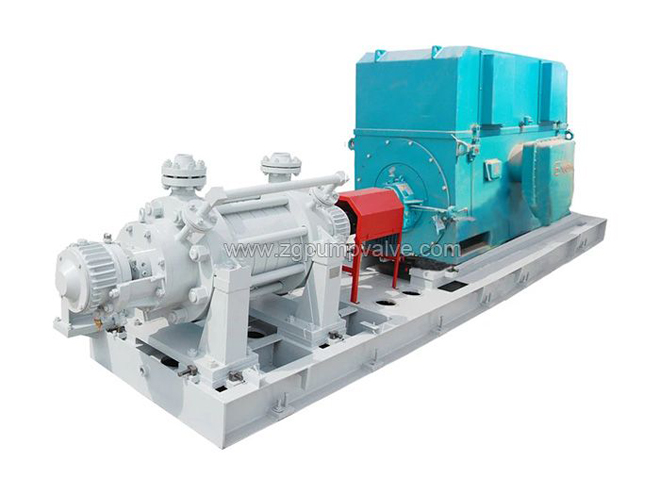Learn - Dec. 20, 2021
There are two main families of pumps; positive displacement and centrifugal (rotational dynamics), both of which have their uses and best areas of application. However, it is important to be able to determine when each pump type should be selected, which ultimately comes down to their operating principles and the application at hand.
Positive displacement pumps are characterized by the operation of moving fluid by trapping a fixed volume (usually in a cavity) and then forcing the trapped fluid into the discharge pipe. A centrifugal pump transmits kinetic energy from the motor to the fluid through a high-speed rotating impeller; as the impeller rotates, it draws in fluid, causing the velocity to increase, thus moving the fluid to the discharge point.
Centrifugal pumps are the most common type of pump used to transport low viscosity fluids in high flow rate, low-pressure installations, which makes them ideal for applications that require the pump to handle large volumes. Centrifugal pump designs are typically associated with the transfer of water but are also popular solutions for handling thin fuels and chemicals.
General water supply
Seawater transfer
Water circulation
Air conditioning
Boiler feed
Light fuel transfer
Petrochemical
Washing and fire fighting
Irrigation
While generally centrifugal pumps are used for cleaning liquids, some solids can be handled if the correct impeller, a vortex impeller, is selected.
Centrifugal pumps have a simple design and few moving parts, which reduces maintenance requirements and costs. This makes them suitable for applications where the pump is used frequently or even in continuous operation. The simplicity of construction also makes centrifugal pumps easy to produce in a variety of different materials, including plastic and cast iron for lighter loads, and bronze and stainless steel for more corrosive or sanitary applications. As a result, centrifugal pumps are suitable for a wide range of fluids.
Centrifugal pumps are also very compact in design compared to other pump types that produce the same level of output, making them a good space-saving option.

Positive displacement pumps are often chosen because of their ability to handle high viscosity fluids at high pressures and relatively low flow rates, as their efficiency is not affected by pressure. While centrifugal pumps are the most common type of pump due to their simplicity, positive displacement pumps are a solution to handle the more difficult conditions in which centrifugal pumps can fail because they are able to operate at any point on their curve.
There are two classifications of volumetric pumps; rotary and reciprocating. Although following the same operating principle, all pump types belonging to these classifications have their own design features and advantages.
Rotary displacement pumps - operated by rotation of the pump element
Screw pumps
Vane pumps
Screw pumps
Peristaltic pumps
Gear pumps
Cam pumps
Reciprocating positive displacement pumps - operate by the constant back and forth motion
Diaphragm pumps
Piston pumps
Generally speaking, positive displacement pumps are designed to transport highly viscous fluids such as thick oils, slurries, sewage, and pastes. Because of their internal clearance, some types such as screw and peristaltic pumps also perform well in applications that handle media with high solids content, including dewatered groundwater and waste oil. On the other hand, screw and vane pumps are well suited for pumping relatively clean fluids, such as fuels and lubricants.
As pumps with lower speeds than centrifugal pump designs, rotary positive displacement pumps with larger chambers (such as progressive cavity pumps, lobe pumps, and peristaltic pumps) are often low-shear pumps that provide smooth flow. This allows them to pump shear-sensitive products that require their structure to remain intact, such as olives that cannot be squashed and adhesives that cannot lose their viscosity, as well as gels that need to maintain their gel-like properties.
Positive displacement pumps can handle changes in pressure, flow, and viscosity and remain efficient, unlike centrifugal pumps, which operate poorly outside the center of their curve. Because they maintain a constant flow rate (proportional to the operating speed) and pulsate smoothly and with little pulsation despite pressure changes, displacement pumps such as peristaltic, piston, and diaphragm pumps are ideal solutions for metering applications because they allow for precise metering out.
As this guide shows, some processes are suitable for centrifugal pumps, while others are suitable for volumetric pumps. It is important to note the application conditions that make one more suitable than the other.
If you want to get more information about the centrifugal pumps, welcome to contact us today or request a quote.
How to extend the service life of chemical pumps - Maintenance of chemical pump properly
Application-Coal fired power generation -Desulfurization pump-Eco friendly
What Are the Water Filling Methods for Centrifugal Pumps(Part 2)?
What Is A SiC / Silicon Carbide Ceramic Lined Desulfurization Pump?
What Is A Self Balancing Wear Resistant Multistage Pump ? (Part Two)